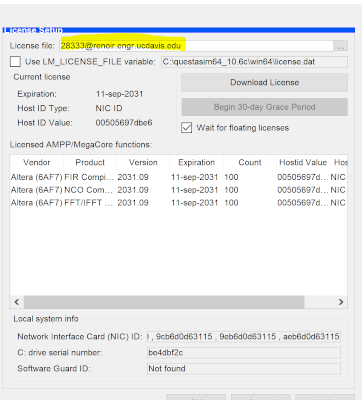As of early 2020, Quartus and Modelsim are available for only the Windows
and Linux operating sytems. For students who own a MacOS-based computer, there
are several options listed below.
Windows 10 is available for free for students from the university
(perhaps only one copy per student).
The opinions below have been distilled from a variety of sources.
-
Borrow a Windows or Linux machine
The obvious easy choice.
-
Dual boot Windows on your Mac using Boot Camp
Installing Windows using Boot Camp might be a better choice if you have a Mac
with very limited hardware resources such as a slow processor and a small
amount of RAM.
The major disadvantage of Boot Camp is that switching from MacOS to Windows
(and back) requires a reboot each time which is very time consuming.
-
Install a Windows virtual machine on your Mac using VMware
VMware Fusion Pro 11.x is available for free given
the students access the CoE IT on the hub webpage,
https://e5.onthehub.com/WebStore/OfferingDetails.aspx?o=f107e09e-42ce-e811-810b-000d3af41938&ws=282952ce-dd3b-de11-b696-0030485a8df0&vsro=8
VMware is also available on the UC Davis hub site but it is not free there.
Both Parallels and VMware allow users to open up individual Windows programs
directly from the Dock.
VMware benchmarks much higher for 3D graphics and for gaming, especially with
OpenGL.
One student had slow VMware response until he allocated 2 GB RAM and 2 cores
to the VM—then everything ran fine. 4 GB of RAM is even better.
-
Install a Windows virtual machine on your Mac using Parallels
Parallels costs a discounted price of $39.99 on UCD IT hub webpage.
Both VMware and Paralles have a set up wizard to go through the installation
process; however Parallels seems to guide a lot more throughout the
installation process. One report says that Parallels works better than VMware
in terms of user friendliness.
Both Parallels and VMware allow users to open up individual Windows programs
directly from the Dock.
Parallels tends to boot faster than VMware, transfer files faster, and saves
battery life better than VMware.
Parallels - https://ucdavis.onthehub.com/WebStore/OfferingDetails.aspx?o=40d7a407-38a2-e811-8109-000d3af41938 (UC Davis IT Hub page) - $39.99/year
-
ssh into ECE Linux machines and run Quartus and Modelsim there
One problem with this approach is the unavailability of linux support for the
System Builder tool. However, students can create a Quartus project directly
and write verilog for the DE-10 board I/Os correctly in the top module once
they are familiar, and that way there is no need for System Builder.
The file installing.software.majority.zip includes a template
top-level module and other required files which take care of pin assignments
and I/O standard settings generated from System Builder. This process is a
little tricky because of the dependencies among the files but the process
is workable.
All files inside the unzipped "majority" folder are for the "majority"
project, which should be good for lab 1. Students can perform the following
changes for a new project:
-
File name
- File contents
No changes in majority.htm and majority.sdc
In majority.qpf,
Line 6, change PROJECT_REVISION = "majority" replacing "majority" with
the new project name.
In majority.qsf,
Line 7, set_global_assignment -name TOP_LEVEL_ENTITY "majority" replacing
"majority" with the new project name.
Line 14, set_global_assignment -name SDC_FILE majority.SDC replacing
"majority" with the new project name.
In majority.v,
Replace module name "majority" with the new project name.
Command to run Quartus prime 16.1 : /software/Altera/16.1/quartus/bin/quartus &
Command to setup Modelsim : setup modelsim
Command to run Modelsim : vsim &
-
Dual boot Linux on your Mac
This is believed to be possible but has not been investigated.

-
Quartus version download instructions: The Quartus tool uses either
"ModelSim" or "Questa" as the default design simulation software. Quartus
version 21 onwards comes with "Questa" as the default simulation software. Make
sure to install Quartus version 20.1 (which is the latest version with
ModelSim as the design simulation software).
ModelSim and Questa are both simulation tools for digital design
verification. Questa is the advanced version, offering additional features
like UVM support, better performance, and tighter integration with the
Mentor Graphics ecosystem. However, it comes at a higher cost compared to
ModelSim, which is a more basic version. The choice depends on specific
requirements and budget considerations. For the EEC 181A/B course,
ModelSim is sufficient.
-
In case you are having trouble receiving the verification email from
Intel, you may download the files including the "Standard" version of
Quartus from this google drive:
https://drive.google.com/drive/u/0/folders/14aJGQkd2ZpX-vJVDmOU0lOHrKiuo_sR-
-
Connect to one of the UCD VPNs.
One is the campus Pulse Secure VPN: vpn.ucdavis.edu
Tutorial: https://www.library.ucdavis.edu/service/connect-from-off-campus/.
Notice that the VPN server address does not include "library" like the
address for the http tutorial.
-
Setup license.
The DE1-SoC board is not compatible with the free "Lite" version of quartus
so you must instead use the "Standard" version which requires a license.
The department has a floating license served by a network license server
that is restricted to students enrolled in EEC 181. To enable your Standard
version of Quartus to use a license from this server, you must be connected
to the UCD VPN, launch the program, and then set the license to
28333@renoir.engr.ucdavis.edu
-
For the board to operate in the FPGA fabric mode which is what
we will normally use for EEC 181, set the DIP switches on the board as
shown in the User Manual (link is on the main course web page) page 12.
The switches will need to be put in different positions to run linux on the
"hard processor" side of the FPGA chip.
